Podcast: Play in new window | Download (Duration: 29:44 — 34.7MB)
Subscribe: Apple Podcasts | Google Podcasts | Spotify | Amazon Music | Android | Pandora | iHeartRadio | JioSaavn | Podcast Index | Email | TuneIn | RSS | More
By Davy Crockett


| This history and the histories of eight other classic races are contained in my new book, Classic Ultramarathon Beginnings, available on Amazon. |
For fixed-time ultramarathons, instead of competing at a fixed distance like 50 miles or 100 miles, the competition involves running the furthest you can in a fixed time. Fixed-time races have existed for centuries, with the first known 24-hour race in 1806, held in England. In the modern post-war era of ultrarunning, the first 24-hour race in America was the 1964 Last Day Run held indoors at the Los Angeles Athletic Club in downtown Los Angeles.
1983 – A Revolutionary Year
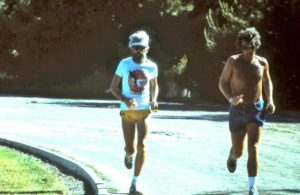

How many of those early fixed-time races still exist? Of the fixed-time races held in America during 1983, Across the Years is one of only three that still exists. Cornbelt Running Club 24 Hour race held in Eldridge, Iowa is the oldest, first held in May 1982. The second oldest fixed-time race is Across the Years held in Arizona, that started in April 1983. Badgerland F/X 24 Hour race, held in Wisconsin, is the third oldest, first held in September 1983.
Many 1980s ultrarunners felt that this race format was “loopy.” One runner wrote that he believed these events were “reserved for masochists” that they “degenerate into a scene with the majority of the competitors parading ghost-like and crippled around the track for what probably seems to be an eternity. Maybe that’s where St. Peter sends bad ultrarunners.” But most of those who have taken part in these races, especially at Across the Years, know the truth, that it can be an amazing experience, especially because you are always in contact with the other runners who you can get to know well.
Best 24-hour Achievements by 1983
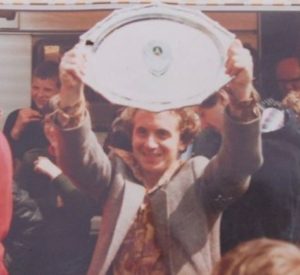

What were the best 24-hour performances as of 1983? The world best for 24-hours at that time was 170 miles, 974 yards on the track, held by Dave Dowdle (1954-) of Great Britain, and 170 miles, 1,231 yards on the road, held by Bernard Gaudin (1949-2010) of France. The American best of 162 miles (which wasn’t ratified for technical reasons) was set in 1979 by Park Barner (1944-) at Huntington Beach, California. The ratified American record was held by Bernd Heinrich (1940-) of Vermont, who ran 156 miles in 1983 at Rowdy 24-Hours on a track at Brunswick, Maine.
Harold Sieglaff – Across the Years Founder
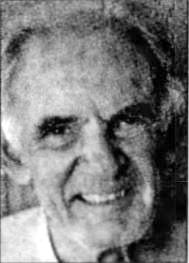

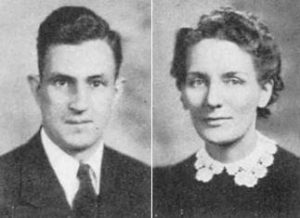

He was the son of Reverend Harold Elmer Sieglaff (1904-1983) and Thelma Savereide Sieglaff (1907-2001). They were from Iowa and South Dakota. Harold Sr. was educated to become a teacher and received a master’s degree from the University of South Dakota. He married Thelma, a nurse, in 1927 and he took teaching jobs. When World War II broke out, he had to register for the draft, but instead of going to war, the Sieglaffs sought to become missionaries and serve the country that way. In 1942, the family moved to Chicago, Illinois where they attended the Moody Bible Institute for their missionary training.
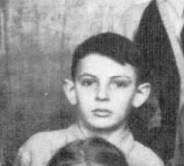

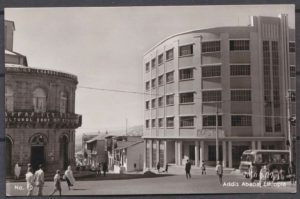

After two and a half years, the Sieglaffs were transferred to Ethiopia where they taught in secondary schools. While in Ethiopia, Thelma gave birth to Genee Lou Sieglaff (Van Wyk). In 1946, young Harold, age 12, was able visit his parents in Ethiopia and met his sister for the first time. His travels took him also to Naples, Alexandria, and Cairo. He later returned to Iowa for the school year.
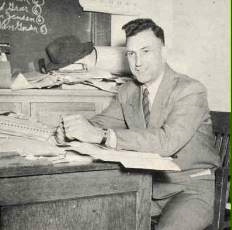

The Sieglaffs worked two more years in Ethiopia and returned home in 1948. Harold Sr. became pastor of a Community Baptist Church in Connersville, Indiana. But by 1949, instead of raising their children, they yearned to return to Africa and accepted a call as educational missionaries to Addis Ababa, Ethiopia. They took three-year-old Genee with them but, left the other children in Iowa to attend school.
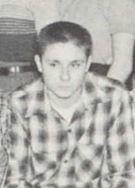

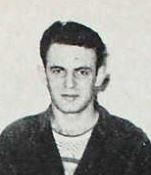

In 1971, Sieglaff took up serious competitive long-distance running, placing well in races from 10 miles to marathons. He ran his first ultra at the age of 47, in 1981, a 50-miler in Scottsdale, Arizona, where he finished in 8:38:52.
1983 Easter Sunrise 24 Hour Track Race
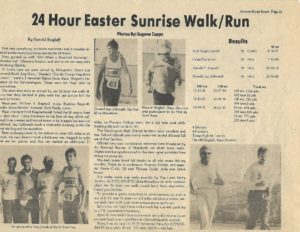

The Runners
Here are brief profiles of the other three pioneer runners who competed.
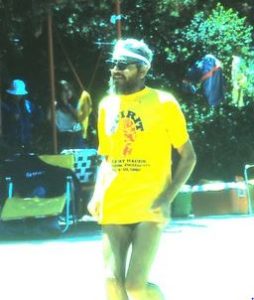

Nagelschmidt enlisted in the Navy shortly after graduating from high school. He then went off to serve his country during World War II, graduated from fleet torpedo school in 1942, and then volunteered for torpedo duty. It was very hazardous duty.
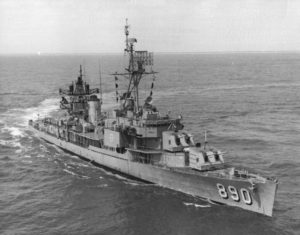

On September 12, 1943, he was severely wounded in France, the third time he had been wounded. He recovered, was promoted, remained in the war, and served on a PT boat and then on the USS Meredith in the Solomon Islands in the South Pacific. After 14 months of duty there, in 1945, he became an instructor at torpedo school in Rhode Island.


After serving for four and a half years, he returned home to Massachusetts, married Mona and went to work for General Electric in Wichita, Kansas, and attended University of Kansas. During Korean War he was recalled into service assigned to the Missile/Space Depot in San Bernardino, where he lived for a decade.
In the 1960s, Nagelschmidt moved to Ventura, California. At the age of 50, he took up long-distance running. His sons ran for Ventura College and a teammate dared him to run with them. He loved the experience and joined “The Sunday Brunch,” a group of twenty or so runners who met each Sunday at Arroyo Verde Park to run up into the hills. Soon he was clocking sub-three-hour marathons, winning his age group. He ran his first ultra in 1977, a 50K at Las Posas Hills, California, where he finished in 3:41:04
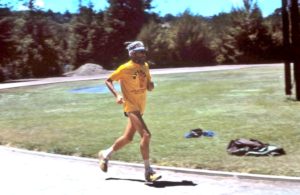

Nagelschmidt set a number of age-group records at various ultra distances. In 1980, he was one of the four runners who ran in the historic first modern-day six-day race, Spirit ’80, put on by Don Choi at Woodside, California. In that race he reached 325 miles. He also ran in the 1982 New Astley Belt Six Day Race El Cajon, California and reached 300 miles, He said, “I don’t get overly serious about ultras, so these events are still a lot of fun for me. At my age what am I going to get out of it if I can’t enjoy myself.” Going into this 24-hour race at age 59, he still had marathon speed close to three hours.
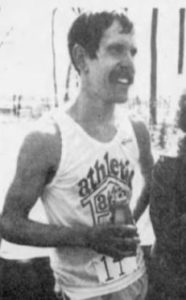

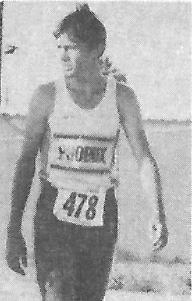

Donald Jay Gilbreath (1964-), age 19, of Arizona was the youngest of the four pioneer runners. This would be his first ultra.
The Historic 24-Hour Race
The Washington High School officials were very supportive of the race and granted full use of the facilities to runners and race staff. The Easter Sunrise 24 Hour race started at 8 a.m. on April 2, 1983, the day before Easter. The runners were greeted with music from a symphony orchestra and vocalist that included, “Oh, What a Beautiful Morning.”
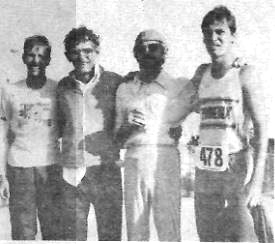

The temperature reached 80 degrees. Davidson, the speedster of the bunch, took the early lead, reached 50 miles first in 7:32:48, but slowed shortly after that because of cramping. At 100 km, Nagelschmidt, who used a run/walk strategy of frequently walking the turns, had about a two-mile lead over Davidson. He was also about 14 miles ahead of Sieglaff.
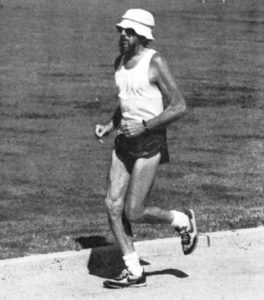

Nagelschmidt won the race, reaching 100 miles in 22:47:44 and finishing with 105 miles. Davidson also reached 100 miles but vowed never to run such a thing again. While his competitors doubted him, he kept his vow. Young Gilbreath reached 50 miles in 22:56:10 and finished with 53 miles. At the finish, the musicians played, “Don’t Get Around Much Any More” and “See the Conquering Hero Comes.”
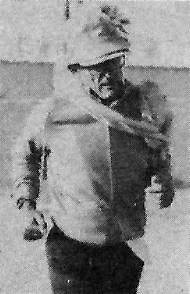

Sieglaff failed to reach 100 miles in the allotted 24 hours. He wrote, “Bitterly disappointed, I took a bath and a rest, hugged my wife and ate her quiche, and then returned to the track for an additional 17 miles.” His total time was 36:21:55.
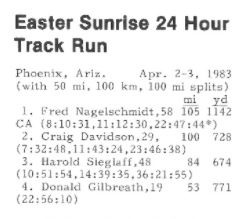

The miles accumulated for the 1983 Easter Sunrise 24 Hour Track Race are included in the Across the Years Lifetime Miles list and Nagelschmidt was given the permanent Across the Years bib number 1.
Across the Years 1983


The Runners
Three elite runners were in the 24-hour race that first year, Lion Caldwell, age 32 of Texas, Steve Warshawer, age 26, of New Mexico, and Sabin Snow, age 41, of New Jersey.
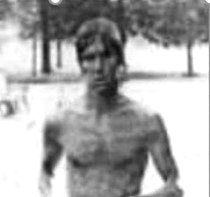

Richard “Lion” Caldwell (1951-) was a doctor from Texas. He acquired the nickname “Lion” as a student at Kansas State University when he was playing with some young children and began roaring to entertain them. While going to medical school in Texas during the late 1970s, he ran about 12,000 miles on the Galveston’s seawall. In 1978, the year before he graduated, he ran his first ultra, the Houston 50-miler which he won in a lifetime best time of 5:36.
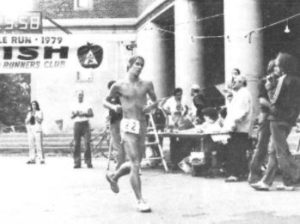

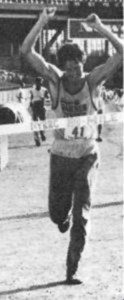

1983 had been a rough year for Caldwell. He said, “January began with two broken ribs compliments of playing basketball. Then in February I turned a lovely shade of yellow, the gracious gift of hepatitis from a patient. It was August ‘till I began to feel semi-human again. In my first try at running after hepatitis, I did a blazing one-mile run in eight minutes and was exhausted. The whole episode showed me I’d taken health too much for granted.” Across the Years would be his only ultra for 1983.
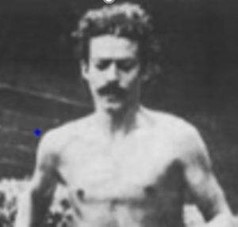

He started to run in college. “I started running as often as I could, running 14 and 15 miles in a day in the morning before work. I’d go right up in the mountains above Santa Fe and end up on top of some peak looking out over the city.” As Warshawer continued to struggle with his addictions, he knew he needed to change his life. “I disappeared into the mountains in southern New Mexico and hid out for a couple of weeks without any drugs, sat in the hot springs and ran.”
In 1982 he ran the Boston Marathon and finished in 2:43. He ran Pikes Peak Marathon in 1981 and 1983 finishing 3rd each time. In 1983 Warshawer burst on the ultra scene and immediately made an impact finishing very high, running 50 miles in 5:33:32 for second place at AMJA 50 behind Western States legend, Jim King. Across the Years would be Warshawer’s first attempt to reach 100 miles and beyond.
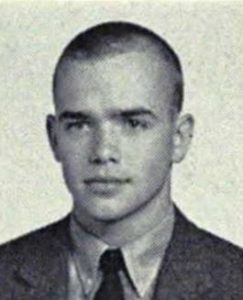

By 1975, Snow was running marathons regularly, with sub-three-hour speed. He ran his first ultra at the age of 36, in 1978, at Lake Waramaug 50 in Connecticut. In 1979 he finished his first 100-miler at the inaugural Old Dominion 100 with a time of 21:12:52. In 1980 he finished second with 345 miles at the historic Edward Payson Weston six-day race at Pennsauken, New Jersey. As a psychologist, he promoted physical fitness. He said, “It has been proven that positive psychological changes result from exercise.” Among the starters at Across the Years, he had the most experience running mega-miles with five 100-mile finishes.
The 1983 Race


A nice touch that Sieglaff added to the race were “root flags.” He and his wife displayed state flags around the track representing the runners’ home states. He said, “Perhaps in the future years we can add ‘root food’: A New York bagel, Texas taco, Alaskan salmon, Arizona Indian fried bread, Georgia peaches, Idaho potatoes, a Washington apple, Wisconsin cheers, Pennsylvania Quaker oats, etc.”
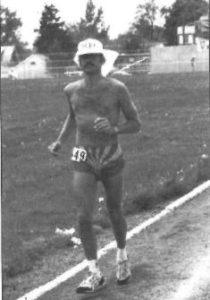

The race started at 7:00 a.m. Caldwell and Warshawer set a blazing fast pace with Warshawer reaching 50 miles in 6:38, and Caldwell less than a lap behind. Snow and all the others were at least 10 miles behind and had been lapped dozens of times by the two speedsters.
As dusk arrived at the 100K mark, Warshawer was in the lead reaching that point in an impressive 8:19. Caldwell was about a mile behind and Snow was in 4th, still about 10 miles behind.
Warshawer continued at a torrid pace and reached 100 miles in 13:54:12. It was the first time he had ever run that far and it was the third fastest 100-mile time in the US on a track at that time. It turned out to be his lifetime personal best. At that point, he took long breaks. Caldwell reached 100 miles in 15:45:42 but needed a long stop to fight off the chills.
The new year arrived and Sieglaff wrote, “Pyrotechnics and cries of ‘Happy New Year’ greeted tired movers 17 hours from the start, while an alto recorder sounded, ‘Auld Lang Syne’ and ‘La Golondrina.’”
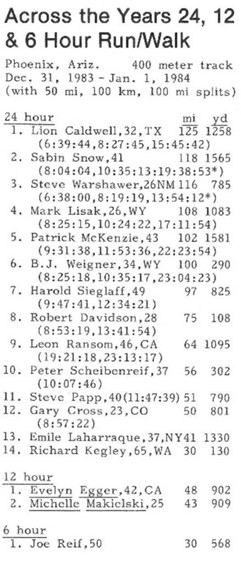

Snow reached 100 miles in 19:38:53, a pace consistent with his past five 100-mile finishes. He refused to be told when he went past 100 miles because he said that too many people let down after that point.
Continuing on, Caldwell passed suffering Warshawer at the 21-hour mark. Snow also eventually passed him. Caldwell walked the remaining three hours, winning the race with 125 miles. Snow finished in second with 118, and Warshawer in third with 116. Sieglaff reached mile 97. Six of the seventeen 24-hour runners reached 100 miles during this first historic Across the Years Event.
What is truly amazing about Caldwell’s victory is that he had only started running slowly again in August since contracting Hepatitis. Ultrarunning historian, Nick Marshall poked fun at him, “Well, it’s nice to see a return to health, but Caldwell’s rapid comeback to 24-hour victory is almost calculated to make the rest of us feel inferior. Thanks a lot Lion!”
The first Across the Years was in the books and Sieglaff hoped that it would be an annual tradition for many years to come. It lasted and grew far beyond Sielaff’s imagination.
Where are they now?
After participating in these historic first 1983 races, what happened to some of these pioneer runners?
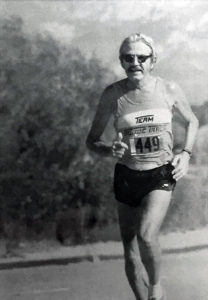

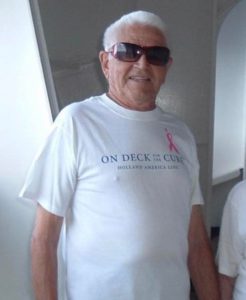

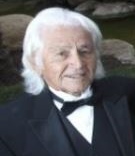

Fred Nagelschmidt passed away in 2019 at the age of 95. Comments on his obituary included, “Fred was ‘the man’ when it came to ultrarunning. He could tell you every trick in the book. He was one of the nicest guys anyone could meet. He always had a big smile and a kind word.”
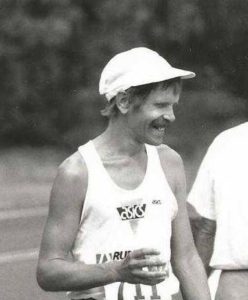

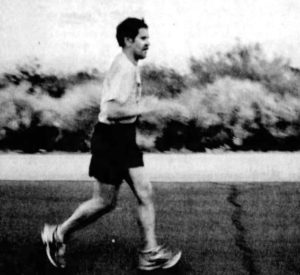

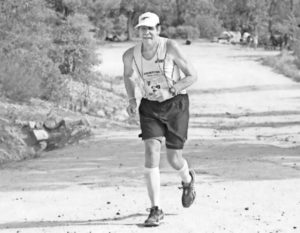

Donald Jay Gilbreath with lifetime bib #4, never ran an ultra again and appeared to have dropped out of long-distance running after his 54 miles at the 1983 Easter Sunrise 24 Hours race.
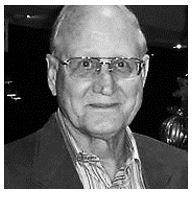

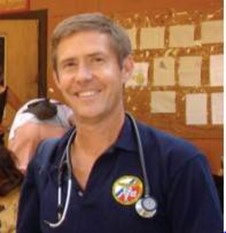

Lion Caldwell with lifetime bib #6, went on in 1984 to win the 100-mile national championship in 13:56:26. He repeated as champion in 1986 with a 100-mile time of 13:53, running a one-mile loop around Shea Stadium in the rain. That was his fifth career 100-miler in under 14 hours. In the late 1980s he also ran trail 100s at Western States and Vermont, but later broke his ankle and had a long recovery. In 1991 he was featured in Ultrarunning Magazine as the “Ultrarunning M.D.”
From 1995-2016, Caldwell served as team doctor for the USA 100K team that competed all over the world. He shared much of his ultrarunning experience with the runners, including Zac Bitter in 2015. In 2021, at the age of 70, he ran 100 miles at 3 Days at the Fair to extend his 100-mile finish longevity career to nearly 43 years, 4th longest in the world. In 2021, he still was a family practice doctor, living in Albuquerque, New Mexico.
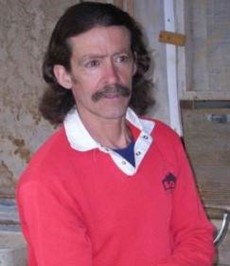

Steve Warshawer, with lifetime bib #8, moved to Marietta Georgia in 1984 and made a huge impact on southern ultras competing with Ray Krolewicz. In 1985 Warshawer was ready to take on his first multi-day race, the Atlanta 48 Hour, on a track, the first multi-day race in the South. He won with 191 miles. He ran the 1985 Old Dominion 100 which he said “was the most important competitive race of my life up to now.” He won and broke the course record with 17:11.
Next up, a month later, in 1985, he made his debut at Western States 100. He made a huge impression, finishing 3rd in 16:51, 48 minutes behind the winner, Jim King. Warshawer’s greatest 100-mile accomplishment came in 1989 at Leadville 100. He won the mountainous race, tied with Rick Spady of Montana and set a course record of 18:04.
After 1991, at the age of 33, Warshawer disappeared from ultrarunning seemingly at his peak. He moved back to New Mexico in 1994 to start farming land he had purchased many years earlier. He still ran marathons, winning the 1996 Taos Marathon in New Mexico with a time of 2:52. He returned to ultrarunning in 2007 at the age of 49 for a couple years but no longer competed in 100-milers. In 2021, Steve Warshawer, age 64 lived in Santa Fe, New Mexico.
Mark Lisak (1956-) from Colorado, with lifetime bib #9, finished in fourth place at the 1983 Across the Years with 108 miles, reaching 100 miles in 17:11:54. He never returned to Across the Years, but had a long ultrarunning career through 2022. He had also run in the first Leadville 100 in 1983, finishing in fourth place with 26:24:13, and has finished at least 80 ultras.
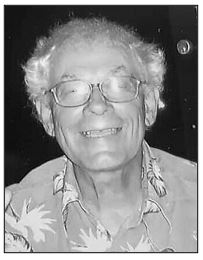

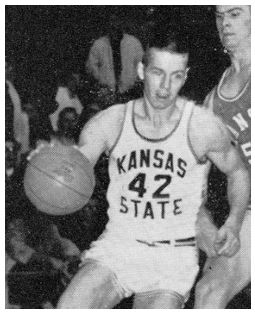

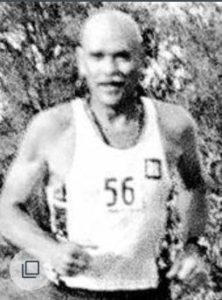

Sabin Snow, with lifetime bib #7, moved to Scottsdale, Arizona in the mid-1980s, where he set up a private psychology practice. While Caldwell never ran at Across the Years again and Warshawer only came back once in 1985, Snow came back three times, including his last year in 1999. He accumulated 446.22 career miles there including a 24-hour win in 1992 at the age of 50 with 112 miles. He retired from ultrarunning in 2001 with about 50 ultra finishes and 15 career 100-mile finishes.
Sabin Snow passed away on Jun 9, 2013, at the age of 71 due to heart complications. During his life he ran 87,000 miles and at the time of his death had 11 grandchildren.
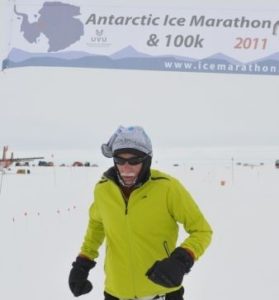

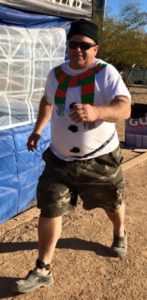

Gary Cross, with lifetime bib #16, was from Colorado at the time and now is from Douglas, Arizona. He ran 50 miles in 8:57:22 during that first Across the Years when he was 23 years old and then stopped after 50 miles. Ten years later he returned and became a fixture at the race. He completed his 1,619th lifetime mile at 2019 Across the Years for his 15th year. He has finished more than 40 races of 100 miles or more and has run ultras for 41 years.
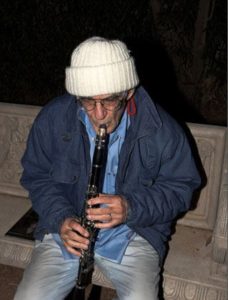

Harold Sieglaff, with lifetime bib #3, who started it all, was the race director of Across the Years until 1997 when he passed it on to Paul Bonnett. Sieglaff was still a fixture at the race, running it for 24 years, piling up lifetime miles of 2,555.35. He had the most career miles for many years, leading by nearly 1,000 miles and participated in almost every race until 2006. For the last few years, he walked it wearing street clothes. Because of his knee problems, he did not return to the race after 2006 and passed away on April 23, 2015, at the age of 80.
His wife Diane wrote to the race, “I know how much Harold loved the Across the Years Race, and it was such a part of his life for so many years. He felt honored that it has continued, and I know he would want everyone that is still part of it to remember him.”
At the 2015-2016 Across the Years, runners ran laps in his honor (foregoing getting credit for the lap on their own results) and accumulated over 100 miles in his memory. A 100-mile buckle was presented to Harold’s wife. In 2021, he was still 6th on the all-time Across the Year career miles list.
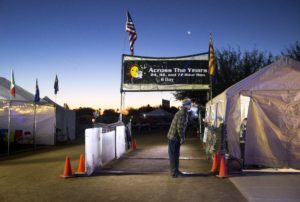

Sources
- Ultrarunning Magazine, Jun 1983
- Nick Marshall, 1983 Ultradistance Summary
- Across the Years Lifetime Miles (last updated 2018)
- Fred Nagelschmidt Facebook Page
- Craig Davidson Facebook Page
- Arizona Road Racer “24 Hour Easter Sunrise Walk/Run”
- The Berkshire County Eagle (Pittsfield, Massachusetts), Nov 11, 1942, Oct 1, Nov 22, 1943, Jun 20, 1945, Mar 1, 1948, Apr 26, 1978, Jun 28, 1990
- Des Moines Tribune (Iowa), Dec 18, 1943
- Argus-Leader (Sioux Falls, South Dakota), May 13, 1946, Dec 13, 1948, Jun 22, 1952
- Palladium-Item (Richmond, Indiana), Dec 11, 1949
- The Courier (Waterloo, Iowa), May 17, 1959
- El Paso Herald-Post (Texas), Jun 23, 1960
- El Pass Times (Texas), Jul 27, 1963
- Arizona Republic (Phoenix, Arizona), Dec 13, 1971, Oct 2, 1993, May 3, 2020
- The Miami Herald (Florida), Mar 4, 1980
- The Courier-News (Bridgewater, New Jersey), Sep 16, 1981
- Argus-Leader (Sioux Falls, South Dakota), May 24, 2001
- Sioux City Journal (Iowa), Feb 1, 1983
- The Los Angeles Times (California), Aug 29, 1985, Apr 13, 1995

